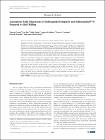| dc.contributor.author | HEALY, ANNE | en |
| dc.date.accessioned | 2014-12-11T10:41:30Z | |
| dc.date.available | 2014-12-11T10:41:30Z | |
| dc.date.issued | 2013 | en |
| dc.date.submitted | 2013 | en |
| dc.identifier.citation | Caron V, Hu Y, Tajber L, Erxleben A, Corrigan OI, McArdle P, Healy AM, Amorphous solid dispersions of sulfonamide/Soluplus® and sulfonamide/PVP prepared by ball milling, AAPS PharmSciTech, 14, 1, 2013, 464-474 | en |
| dc.identifier.other | Y | en |
| dc.identifier.uri | http://hdl.handle.net/2262/72412 | |
| dc.description | PUBLISHED | en |
| dc.description.abstract | The aim of this paper is to investigate the physicochemical properties of binary amorphous dispersions of poorly soluble sulfonamide/polymeric excipient prepared by ball milling. The sulfonamides selected were sulfathiazole (STZ), sulfadimidine (SDM), sulfamerazine (SMZ) and sulfadiazine (SDZ). The excipients were polyvinylpyrrolidone (PVP) and polyvinyl caprolactam-polyvinyl acetate-polyethylene glycol graft co-polymer, commercially known as Soluplus®. Co-milled systems were characterised by powder X-ray diffraction and differential scanning calorimetry. PVP was shown to form amorphous dispersions over a wider composition range than Soluplus® for the four sulfonamides tested. Moreover, amorphous dispersions made with PVP were homogeneous [single glass transition (Tg)], while amorphous dispersions made from Soluplus® were heterogeneous (two Tgs). This behaviour is consistent with the fact that all the sulfonamides tested presented a lower solubility in Soluplus® than in PVP, as evidenced by Flory-Huggins parameters determined. Amorphous dispersions of SDM with Soluplus® could be produced even though SDM does not amorphise alone upon milling and Soluplus® presents Tg at a lower temperature than SDM. Amorphous dispersions of SMZ could be prepared with a lower excipient concentration compared to STZ, SDM and SDZ, which may reflect the one-dimensional H-bonding network in SMZ compared to the 2D or 3D H-bonding network found in the other sulfonamides. Stability tests (60% RH/25°C) revealed that dispersions made with Soluplus® remained dry and powdery compared to those made with PVP that formed a sticky paste in less than 2 weeks, indicating a possible advantage of using Soluplus® in terms of increased physical stability under high humidity storage conditions. | en |
| dc.description.sponsorship | This paper is based upon works supported by the Science
Foundation Ireland under grant no. [07/SRC/B1158] as part of
the Solid State Pharmaceutical Cluster (SSPC) | en |
| dc.format.extent | 464-474 | en |
| dc.language.iso | en | en |
| dc.relation.ispartofseries | AAPS PharmSciTech | en |
| dc.relation.ispartofseries | 14 | en |
| dc.relation.ispartofseries | 1 | en |
| dc.rights | Y | en |
| dc.subject | milling and Soluplus® | en |
| dc.subject.lcsh | milling and Soluplus® | en |
| dc.title | Amorphous solid dispersions of sulfonamide/Soluplus® and sulfonamide/PVP prepared by ball milling | en |
| dc.type | Journal Article | en |
| dc.contributor.sponsor | Science Foundation Ireland (SFI) | en |
| dc.type.supercollection | scholarly_publications | en |
| dc.type.supercollection | refereed_publications | en |
| dc.identifier.peoplefinderurl | http://people.tcd.ie/healyam | en |
| dc.identifier.rssinternalid | 87959 | en |
| dc.identifier.doi | http://dx.doi.org/10.1208/s12249-013-9931-7 | en |
| dc.rights.ecaccessrights | openAccess | |
| dc.contributor.sponsorGrantNumber | 07/SRC/B1158 | en |
| dc.identifier.orcid_id | 0000-0001-5093-9786 | en |




